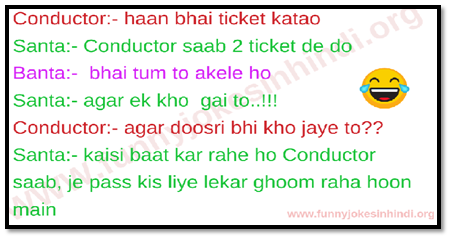

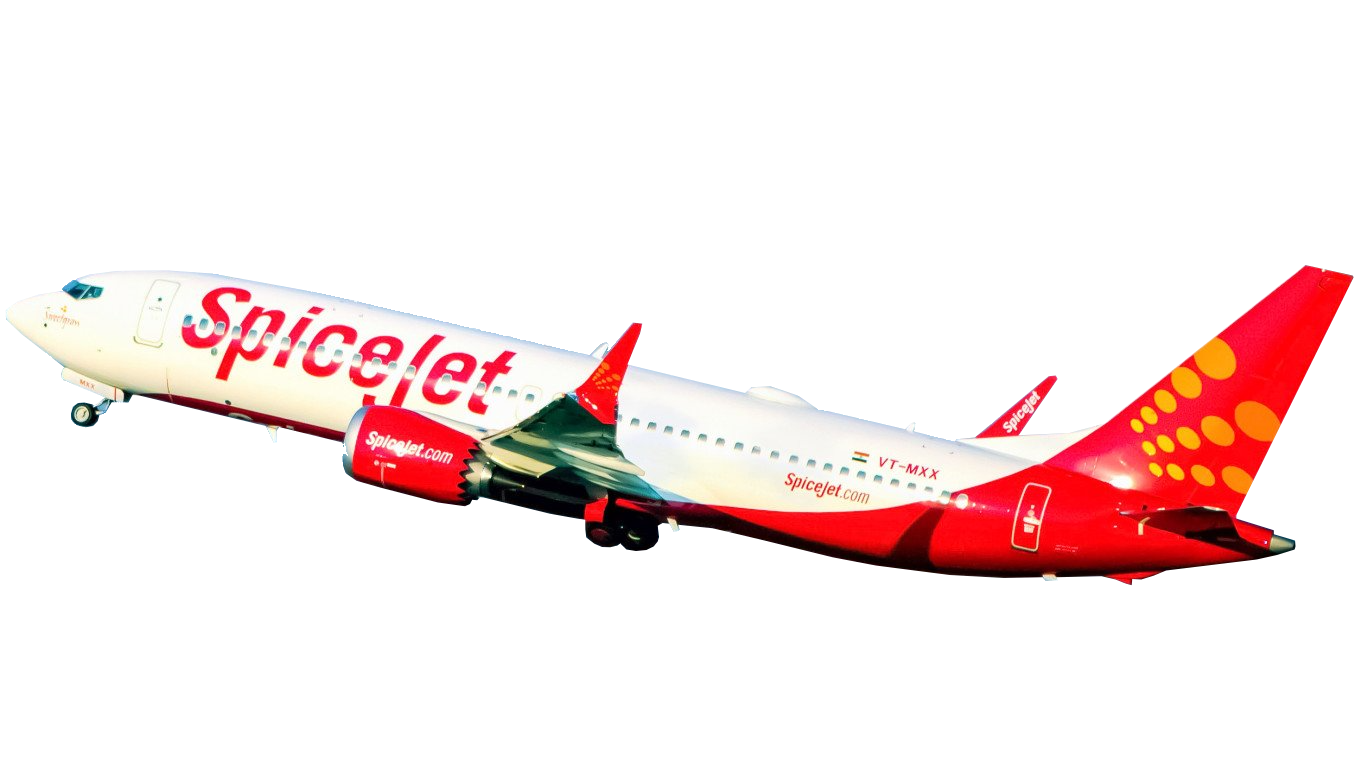

Dear Smiling Teammates,
July 2022 edition of SpicyReflection magazine will be our 5th edition and I would like to thank you all for sharing your Ideas/Articles for this magazine.
We always bring a new topic in every edition that help us in our professional as well as personal life. In the last edition of SpicyReflection we covered the topic ‘Impediments to Success’, under the series ‘Nurture your talent’. In this Edition of our magazine we will talk about an important factor of our career under the topic‘Stress Management’. This article will help us to escape the negativity and to focus on the positive energies around us which lead us towards our career growth.
Also in this edition we have travelled to South-West India to the city ‘Belagavi’ which is famous for its temples. We will share the vast history and culture of Belagavi under the topic “My City My Place”. It will be a great article to read to know more about the beautiful city.
In this edition we have brought great poetry’s shared by Mr. Sumit Sharma (ATQ)& Mr. Shahnawaz Hussain (CCU) and an article on “Purifying Our Soul “where we talk about the importance of meditation in our lives.
I would also like to congratulate the winner of SpicyReflection Quiz (June 2022 Edition) Ms. Sathya Bose from Madurai on her win. We would also like to see more of our colleagues participating in the quiz and winning surprise gifts.
Recently we celebrated Father’s Day, World Blood Donor Day and International Yoga Day in this last month. We have received great moments which were captured at the airports.Keep up the great work!! We would also encourage rest of our employees to participate more actively on our social media page as it helps to highlight our employees and their talent of a larger platform.
Hope you all will enjoy this edition of our Digital Magazine filled with knowledgeable and interesting facts and will share your feedback and ideas for the next edition. Also Enjoy our fun filled social media page “SpicyReflection” page on Instagram, Facebook and YouTube.
Jai Hind!
Your Captain
GP Gupta
Stress
Stress is a feeling of emotional, psychological or physical tension.It is our body's reaction to a challenge or demand. In short bursts, stress can be positive, such as when it helps you avoid danger or meet a deadline.
What is stress?
Stress is buildup of mental pressure with respect carrying out some activities, job or some uncertain situations like serious diseases or uncertainty of business, uncertainty of income, uncertainty of relationships etc. Stress is a normal human reaction that happens to everyoneon adaily events.
In fact, the human body is designed to experience stress and react to it. There are several sources of stress and as many ways to react to it. Fundamentally, stress is a human defense mechanism, but it is important to not let it take over. When we experience changes or challenges, our body produces physical and mental responses. During that time, when we are unable to manage our system, then, that’s stress.
Stress responses help our body adjust to new situations. Stress can be positive, keeping us alert, motivated and ready to avoid danger. For example, if we have an important test coming up, a stress response might help our body work harder and stay awake longer.
What are the Causes for Stress:-
Stress comes from various sources of a different nature, such as physical, psychological, emotional, social, etc
Few basic causes of stress are:-
• Intensified workload to increase productivity gains;
• Over thinking;
• Lack of Confidence;
• Constant search for perfection;
• Obsession with competition;
• Difficulty balancing work, personal life and family life;
• Changes in values and social standards.
What happens to the body during stress?
The body’s autonomic nervous system controls our heart rate, breathing, vision changes and more. Its built-in stress response, the “fight-or-flight response,” helps the body face stressful situations.
When a person has long-term (chronic) stress below physical, emotional and behavioral symptoms develop.
Physical symptoms of stress include:
• Aches and pains
• Chest pain or a feeling like your heart is racing
• Exhaustion or trouble sleeping
• Headaches, dizziness or shaking
• High blood pressure
• Muscle tension or jaw clenching
• Stomach or digestive problems
• Weak immune system
Stress can lead to emotional and mental symptoms like:
• Anxiety or irritability
• Depression
• Panic attacks
• Sadness
Often, people with chronic stress try to manage it with unhealthy behaviors, including:
• Drinking alcohol too much or too often
• Gambling
• Overeating or developing an eating disorder
• Unmindfully excessive Shopping or internet browsing
• Smoking
• Using drugs
Which further aggravates the situation.
How is stress diagnosed?
Stress is subjective — not measurable with tests. Only the person experiencing it can determine whether it's present and how severe it feels.
What are some strategies for stress relief?
You can’t avoid stress, but you can stop it from becoming overwhelming by practicing some of the following daily strategies:-
• Exercise when you feel symptoms of stress coming on. Even a short walk can boost your mood.
• At the end of each day, take a moment to think about what you’ve accomplished — not what you didn’t get done.
• Set goals for your day, week and month. Narrowing your view will help you feel more in control of the moment and long-term tasks.
• Consider talking to a Mentor, Someone whom you can confide to, therapist or your healthcare provider about your worries.
• Have unwavering faith, trust and confidence in the Supreme Almighty ( God )
• Have faith in yourself.
• Have faith in the system, and the environment around you
• Stay positive
Why Successful people do not have Stress?
According to various surveys and other research, successful people have some strategies in common when it comes to managing stress.
• They practice gratitude for what they have.
• They stay positive.
• They focus on progress, not perfection.
• They practice self-care.
• They rely on routines.
• They keep the big picture in view.
How to manage Stress:-
Master in these four strategies for coping with stress: avoid, alter, accept and adapt.
1. Avoid:-
• Avoid weapons of Self Destruction:-
Like Ego, Jealousy, Excessive indulgence in Social Media, Gambling, Smoking, Drugs,Alcoholetc, drinking of stimulators like tea or Caffine.
• Avoid people who bother you
• Learn to say “NO”.
• Ditch part of your list: - Label your to-do list with A's, B's and C's, according to importance. On hectic days, scratch the C's from your list.
2. Alter:-
• Respectfully ask others to change their behavior.
• Communicate your feelings openly
• Manage your time better
• State limits in advance.
3. Accept:-
• Talk with someone:-
Phone or schedule a coffee break with an understanding friend/family member. You may feel better after talking it out
• Forgive:-
Forgiving may take practice, but by doing so you will free yourself from burning more negative energy. Why stew in your anger when you could shrug and move on? As anger/frustration depletes your own energy.
• Practice positive self-talk:-
Be positive
• Learn from your mistakes:-
You can't change the fact that procrastination hurt your performance, but you can make sure you set aside more time in the future.
• Accept that you can’t control everything. Find ways to let go of worry about situations you cannot change
4. Adapt:-
• Adjust your standards:-
Redefine success and stop striving for perfection, and you may operate with a little less guilt and frustration.
• Practice thought-stopping:-
Stop gloomy/negative thoughts immediately. Refuse to replay a stressful situation as negative, and it may cease to be negative.
• Reframe the issue:-
Try looking at your situation from a new viewpoint. Instead of feeling frustrated that you're home with a sick child, look at it as an opportunity to bond, relax and finish a load of laundry.
• Adopt a mantra:-
Create a saying such as, "I can handle this," or “Is it Impossible?” and mentally repeat it in tough situations
• Create an assets column:-
Imagine all of the things that bring you joy in life, such as vacation, children and pets. Then call on that list when you're stressed. It will put things into perspective and serve as a reminder of life's joys.
• Look at the big picture:-
Ask yourself, "Will this matter in a year or in five years?" The answer is often no. Realizing this makes a stressful situation seem less overwhelming
• Practice:-
• Wellbeing of others
• Do Good deeds
• To take good care of your body each day. Eating right, exercising and getting enough sleep help your body handle stress much better
• Relaxation activities, such as meditation, yoga, breathing exercises and muscle relaxation.
• Acknowledge the good parts of your day or life
• Make Good Friends
• Stay Positive, Charged and energized
• Stay Focus
• Be Polite and Humble
• To stay connected with people who keep you calm, make you happy, provide emotional support and help you with practical things
• Have Gratitude towards God, Life, People and surrounding.
• Enjoy Life
• Spread Happiness and Be Happy
• Learn to say “NO” to additional responsibilities when you are too busy or stressed
Practice applying these techniques to balance your stress equation. With practice, that once-hefty backpack will become your private bag of tricks.
Always remember it is your Life "You define your own life. Don't let other people /situation / circumstances write your script."



Purifying Our Soul

Meditation on the inner light and sound helps purify the soul
If we analyses ourselves, we find that our soul is encrusted with a layer of impurities caused by countless thoughts, words and deeds we commit throughout our lives. Enlightened souls have been teaching humanity how to alter negative habits so that the soul can attain the state of purity of thought and equanimity to achieve success in the spiritual quest. They have freed themselves from the clutches of mind, matter, and illusion. They know their way through the treacherous seas and can offer us guidance on how we too can safely reach our journey’s end.
To reunite with God, our soul needs to be free from all that is not spiritual, all that is not consciousness, all that is not love. The gateway to spiritual realms is open to only those who have purity of their soul. In this world, we need the right qualifications to enter college or to hold a certain job. Similarly, God has certain requirements for soul to re-enter His domain. The basic prerequisite is to have cleanliness of the soul, with not even a speck of impurity. With eons of negative impressions covering us, how can we ever hope to be purified.
The time we spend in meditation and in developing ethical virtues is within the realm of our free choice. If we spend time in meditation, we are protecting our soul from the stains of any new karmas, the accumulation of all our thoughts, words and deeds, for which we are held accountable.
It is important that we understand how the pursuit of meditation and ethical living are stepping stones to God’s kingdom.
The process of meditation on the inner light and sound helps purify our soul. In this process, we focus our attention at the third or single eye located between and behind the two eyebrows. We sit in a relaxed and comfortable pose in which we can sit the longest. During this time we withdraw our attention temporarily from the world, our body and our thoughts. Our mind must be still in order to see the inner manifestations of God.
In meditation, we have to deal with the mind, whose job is to keep us tied to the outer world. It will try to produce one thought after another. Mind is a powerful agent that loves to become engrossed in the world’s attractions. As long as our soul is identified with the mind, it will also be dragged to the worldly temptations. The force of the mind is one of the greatest hindrances on our path back to God. It will keep us busy in accumulating more and more karma to our already full storehouse.
There are three kinds of karma that we accumulate. There is sanchit or storehouse karma. These are karmas that we accumulated in our previous lives. Then there is the pralabdh or fate karma. This is the portion of our sanchit or storehouse karmas allotted to us for the current life. Finally, there is kriyaman or daily karma. These are the new karmas that we make in our current life. At the end of our life, the kriyaman karmas form part of our storehouse karma. Looking at these three types of karmas, we can see why our storehouse is full and how difficult it is to extricate ourselves from their influence upon us.
The more we come in contact with the inner light, the more our soul is cleansed of these karmas. It will become purer and purer until it is fit to re-enter the spiritual realms of purity.
Many think that good deeds can bring about our return journey to God. Few realise that even good deeds are adding to our storehouse of karmas. Whether we do good or bad ones, we are still performing actions for which have to receive either a reward or a punishment. Lord Krishna has said that both good and bad deeds are like chains of gold or of iron that keep us tied to the world. But the time spent in meditation and remembrance of God does not create new karmas or tie us to the world. It is an action which will help speed our voyage back to the lord.
The Transformative Power of Meditation
The light and sound is a stream of love. When we meditate, the divine love of God touches our soul. It permeates our being and fills us with love and bliss. Contact with this rapturous power transmutes us into itself. As a result we become more loving. We develop a sweetness and kindness that radiates from our very soul.
In this state, we no longer become involved in vices that blemish our soul. We develop a loving heart and cannot injure or hurt anyone. We can only speak kind words and perform kind deeds. We become more peaceful and less susceptible to anger. We become sweet, loving and humble. “When we are lost in the love of our beloved, where is the time to think of others and where is the time to engage in gossip and criticism”
By losing our heart and soul in the love of the creator, our life becomes more spiritual and more sublime.
Daily meditation helps us counteract the negative influences and impressions we receive during our day-to-day life in the world. The pull of the world is very strong and we need all the help we can get to keep us moving towards our goal. Our soul, which is of the same essence as God, finds bliss in the presence of pure consciousness. Once we taste the divine waters of the inner sound current, we want to drink it more and more. This turns our attention towards the goal of travelling to the heavenly regions. We lose our attraction for outer enjoyment. We are also saved from the negative traits that accompany each outer temptation.
When we are not caught up in worldly desires, we have less anger, less greed, less egotism, and less possessiveness. Since our goal is to reach the inner worlds, all the negative habits sparked by worldly attachments slowly begin to fade away.
An indispensable factor for treading the way back to God is to develop ethical virtues. One way of developing ethical virtues is simply to dive into the sea of love and become so absorbed that we have no time or interest to get involved with negative habits and failures. We will become so lost in the love of God that we will not have the time to criticize anyone or get involved in petty disputes. We will have no time to fight over possessions. Instead, we will be interested in uniting our soul with God and spending time in those activities which will speed us towards that goal.
Until we reach that state, we have to consistently weed out our ethical failures one by one, day by day. These are replaced by the positive virtues of non-violence, truthfulness, purity, humility, selfless service, and the maintenance of vegetarian diet. We will want to avoid hallucinogenic drugs and alcohol, which lessen our consciousness and are a deterrent to our goal of becoming more conscious. As long as we continue to have failures in these categories, we are besmearing our soul with more and more blemishes and more and more karma. At the end of each day, we need to evaluate our thoughts, words, and deeds and become aware of our failures in each category. We then resolve to do better the following day and eliminate these deficiencies.
If we wish to reach God in this lifetime, we should spend daily time in meditation. We cannot undo our long past, but we can take charge of our future. We can use our discrimination to make choices which will help our soul reach its eternal goal in this lifetime. The spiritual adepts have given us a blueprint for our personal transformation. It is up to us to take the first step.
By Mr. Lekhraj Parmar (Sr.General Manager - Ground Support)
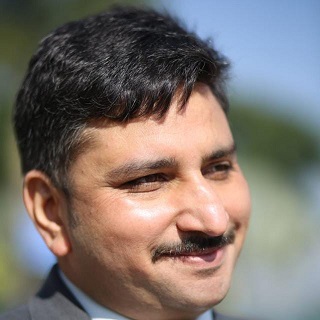
17th Dec. 1903, was a starting of a new era, which has taken humans to moon and beyond.
Many aviation companies were formed, however two aviation companies today have maximum impact on world aviation- Boeing and Airbus.
We use Aircrafts from Boeing (B-737) and De Havilland (Q-400). Let’s talk about Airbus Industrie to begin with
Airbus Industrie was formally established as a Groupement d'Intérêt Économique (Economic Interest Group or GIE) on 18 December 1970. It had been formed by a government initiative between France, West Germany and the UK that originated in 1967. It has a global presence with more than 125000 employees. Airbus is a leader in designing, manufacturing and delivering aerospace products, services and solutions for commercial aircrafts, helicopters, security and space segments.
The company's main civil aeroplane business is conducted through the French company Airbus S.A.S. based in Blagnac, a suburb of Toulouse, with production and manufacturing facilities mostly in the European Union and the United Kingdom
The Airbus numbering system is an alpha numeric model number followed by a dash and a three digit number.
The model number often takes the form of the letter "A" followed by a '3', a digit, then followed normally by a '0', for example A350. There are some exceptions such as: A220, A318, A319, A321 and A400M.
Below are a few links for more information on Airbus
Evolution of Airbus Planes (1972-2021)
Airbus Commercial Aircraft formation flight: 50-year anniversary
Airbus Documentary The History Of Airbus
In the next issue we will talk more about the iconic Aircrafts designed and manufactured by Airbus………….
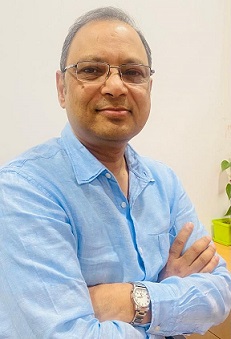
Dear Colleagues,
Being in the airline industry, you must have often heard the complex terms like MoCA, DGCA, AERA, AAI, BCAS, ICAO, IATA, etc. and wondered what they really mean. You may also have been asked by friends & family about who regulates Indian and international airlines and other aviation service providers and what are the rules that govern this highly sensitive and safety conscious sector.
Below is the quick simplification of these so called complex terms, describing in short the functions of the various organization that regulate Indian and International aviation, and the rule making bodies which each aviation company (Airlines, MRO, Air Cargo, etc.) must follow. If there is any breach of any rule, the company can loose its license to operate or be fined heavily and even be punished under law.
1. MoCA: Ministry of Civil Aviation
• MoCAis responsible for formulation of national policies and programmes for the development and regulation of the Civil Aviation sector in the country.
• It is responsible for the administration of the Aircraft Act, 1934, Aircraft Rules, 1937 and various other legislations pertaining to the aviation sector in the country.
• MoCA exercises administrative control over attached and autonomous organizations like the Directorate General of Civil Aviation (DGCA), Bureau of Civil Aviation Security (BCAS) and Indira Gandhi RashtriyaUranAkademi(IGRUA) and affiliated Public Sector Undertakings like Airports Authority of India (AAI) and Pawan Hans Helicopters Limited (PHHL).
• Its headquarteris located Rajiv Gandhi Bhavan at the Safdarjung Airport in New Delhi.
For more details on MoCA, click here
2. DGCA: Directorate General of Civil Aviation (India)
• DGCA is the regulatory body in the field of Civil Aviation primarily dealing with safety issues.
• It is responsible for regulation of air transport services to/from/within India and for enforcement of civil air regulations, air safety and airworthiness standards. It also co-ordinates all regulatory functions with International Civil Aviation Organisation.
• The headquarter is located in New Delhi with regional offices in the various parts of India.
For more details on DGCA, click here
3. AERA: Airports Economic Regulatory Authority of India
• AERA regulates tariff for the aeronautical services, determines other airport charges for services rendered at major airports and monitors the performance standards of such airports.
• AERA plays a vital role in fostering a healthy competition amongst all Major Airports, encouraging investment in airport facilities, protection of reasonable interests of users, operation of efficient, economic and viable airports through regulations of tariff for aeronautical services/activities and also monitors performance standards at Major Airports.
• The headquarteris located AERA Building at the Safdarjung Airport in New Delhi.
For more details on AERA, click here
4. AAI: Airports Authority of India
• AAI’s role is to accelerate the integrated development, expansion, and modernization of the operational, terminal and cargo facilities at the airports in the country conforming to international standards.
• Its mission is to be the foundation of an enduring Indian Aviation network, providing high quality, safe and customer-oriented airport and air navigations services thereby acting as a catalyst for economic growth in the areas we serve.
• The headquarter is located Rajiv Gandhi Bhavan at the Safdarjung Airport in New Delhi.
For more details on AAI, click here
5. AAIB: Aircraft Accident Investigation Bureau
• AAIB is responsible for classification of “Safety Occurrences” involving aircraft operating in the Indian Airspace into Accidents, Serious Incidents and Incidents.
• All Accidents and Serious Incidents involving aircraft with All up Weight (AUW) more than 2250 Kgs are investigated by AAIB (and other incidents if it sees fit). The sole objective of the investigations ordered by the Director General, AAIB is prevention of accidents and incidents and not to apportion blame or liability.
• AAIB also makes “Safety Recommendations” on the basis of safety studies conducted from time to time. The recommendations made in the Investigation Reports and Safety Studies are forwarded to the DGCA, India or Civil Aviation Regulatory bodies of ICAO Contracting States for their follow up and to obtain compliance of the same.
For more details on AAIB, click here
6. BCAS: Bureau of Civil Aviation Security
• The main responsibilities of BCAS include laying down standards and measures with respect to security of civil flights at international and domestic airports in India.
• BCAS headquarter is located at JanpathBhavan, New Delhi. It has got four Regional Offices located at International airports i.e. Delhi, Mumbai, Kolkata and Chennai.
For more details on BCAS, click here
7. ICAO: International Civil Aviation Organization
• The International Civil Aviation Organization is a specialized and funding agency of the United Nations, tasked with the planning and development of safe international air transport.
• ICAO supports the cooperation of 193 national governments in air transport as signatory states to the Chicago Convention (1944).
• Once governments achieve diplomatic consensus around a new standard’s scope and details, it is then adopted by those same 193 countries in order to bring worldwide alignment to their national regulations, helping to realize safe, secure and sustainable air operations on a truly global basis.
• Its headquarter is located in the Quartier International of Montreal, Quebec, Canada.
For more details ICAO, click here
8. IATA: International Air Transport Association
• International Air Transport Association) (IATA) is a trade association of the world's airlines, representing some 290 airlines or 83% of total air traffic. IATA supports many areas of aviation activity and helps formulate industry policy on critical aviation issues.
• IATA’s mission is to represent, lead, and serve the airline industry. IATA supports airline activity and helps formulate industry policy and standards.
• IATA’s vision is to work together to shape the future growth of a safe, secure and sustainable air transport industry that connects and enriches our world.
• Its headquarteris in Canada in the city of Montréal, with executive offices in Geneva, Switzerland.
For more details, click here
If you are curious about more details of each organization, please go through the links provides above.
Wish you a super successful aviation career!
Warm Regards,
Suryavir Singh Bisht
Senior General Manager – Regulatory Affairs
My name is Aakash Pal and I am working with SpiceJet’s Delhi Security team, and I would like to use the SpicyReflection platform to tell youa little bit about myself.
I like music a lot since childhood and I have been playing instruments since I was 4 or 5 years old and this is God gifted talent. Being from a Christian family I have been playing in the church since my childhood, I learned playing musical instruments from my church as I participate in warship every Sunday in the church.
I used to do musical shows before joining the SpiceJet, and I can play musical instruments like Tabla, Cajon, Djambes, Darbuka, Dholak, Conga, Chonggo, Bongo, Drum, Guitar, Ukulele, Harmonium, Keyboard, Piano, Kazoo and Tambourine. I can play any musical instrument made for rhythm.
I would like to thank and appreciate my SpiceJet team who supported me to pursue my hobby for music and till date I am performing in different shows in my free time. Music gives me a sense of peace and satisfaction. I love to sing songs and even I got to showcase my talent at SpiceJet HO during one of the Fun Friday event and was very much appreciated by all.
I would again thank all my team members and will continue my musical journey.

I am Susmita Mahanti and am from the City of Joy – Kolkata! My family consist of by 5 people: My father, who works in Border Security Force; my mother, who is a business woman; and I also have a sister and brother - they are twins!
From a young age I wanted to work in an aviation industry. But growing up, I felt that I should do something different within the world of work. So, after successfully completing the higher secondary examinations, I started learning “Makeup”. Within a very short period of time I started to love learning Makeup so much that I made it my rewarding hobby! Within one year I was able to become a much in demand Makeup Artist. Now, I have a set up at Dakhineshwar where I demonstrate Makeup to others and also guide for Bridal Makeup. Apart from that, I’m Nail Artist and Beautician too.
After completed my graduation, I got an opportunity to work with SpiceJet and now I am working as a CSE with SpiceJet. As I have to maintain these two sides of my personality, it would not have been possible without SpiceJet’s team support. SpiceJethas always helped me to learn how to find out the way to balance to my professional life and also to pursue my hobby as well.
Today I’m very glad to be a member of SpiceJet and thank you the entire team for always supporting me.







Belagavi
Belgaumis famous for its temples and travelerscan find a large number of temples here-the main ones being Kamal Basti (in BelgaumFort)KapileshwarTemple, Shani Temple and the Maruti Temple.
Belgaum has now become one of the important and considered districts in the state of Karnataka. Belgaum is now marching with a tag of fast growing, redeveloping district. The name Belgaum is originated from “Velugrama” or “Ikhsugrama”.
Belgaum was founded in late 12th century AD by the Ratta dynasty, who shifted from nearby Saundatti. A Ratta official named Bichiraja built Kamal Basadi, a Jain temple, dedicated to Neminatha in 1204, which came to be called Kamalabasti.
Belagavi city was earlier known as VENU GRAM from the Sanskrit word VENU GRAMAi.e BAMBOO VILLAGE. Of late, the city has carved itself a new name as “KUNDA NAGARI” because of the sweet dish “KUNDA” made with milk, sugar & spices.
The Belgaum city is in the northwestern parts of Karnataka and lies at the border of two states, Maharashtra and Goa on the Western Ghats (50 km (31 miles) from the Goa state border). On the northern part at 499.0 km (approx.) north of Bangalore and 550.0 km (approx.) from Mumbai. City is 150.0 km (approx.) away from Goa airport. Addition to this in just 100km distance from Belgaum we have “City of Temple” Kolhapur-District.
Belgaum City is having the prestigious “SuvarnaVikasSoudha” and proposed second capital of Karnataka. It is the biggest district and fourth largest city of Karnataka State. City situated near the foot hills of “Sahadri Mountain Range” known as “Western Ghats”.
Education and Tourist places:
Belagavi is an educational hub (various Medical & Engineering colleges, Visvesvaraya Technological University (VTU),which is a leading technical institute, is located in the city and governsmany the Engineering colleges of Karnataka state.
There are many tourists’ spots in and around Belagavi which also have high influx of tourists like “Aihole”, “Pattadakal”, “Gokak Falls”, “Badami”, “Hampi”, etc.
Brief History about Belagavi Airport:
It was established by Royal Air Force in 1942. Indian Airlines commenced operations from 1947.
From the year 1989 to 2011, various private Airlines operated at Belagavi Airport.
From the year 2012 SpiceJet started its operation and continues till date.
Something really important things to know about:
This fort is controlled by arm force MARATHA LIGHT INFANTRY and declared as defense land.
• The Central Jail- 1923: To maintain the law and order of the town, the Britishers had to build a secured prison for imprisoning freedom fighters and some criminals. All these factors led to the formation of the Hindalga Jail in the year 1923 with a total capacity of 1162 and 3 gallows for capital punishment.
• Commando School Belgaum:
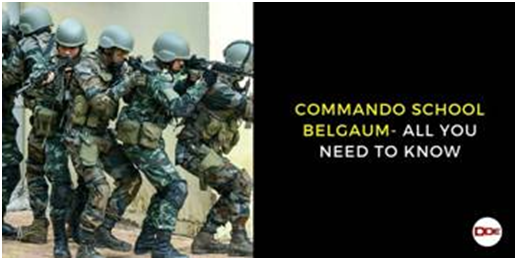
Click on below link to watch this on YouTube (The complete episode is available on National geographic channel)
Indian Commando School Belgaum - Making Men Out of Boys
Commando School Belgaum is one of the premier training institute of Indian Army. The school provides the commando training to the young soldiers and officers of the Indian Army. The Officers and Soldiers, who graduate from this school join the Ghatak platoon of their Units.
The Commando School is located in Cradle of Infantry Belgaum, Karnataka. The Maratha Light Infantry Regimental Centre and Junior Leaders Wing is also situated along with the Commando School.
Training
The training program in the Commando school is held for 35 days. A total of 350 trainees are taken into the single batch.
The Soldiers and Officers are trained in:
1. Unarmed Combat
2. Day and Night Navigation
3. Cliff climbing
4. Weapons training
5. Heliborne Insertion
The Exercise Tod Phod is conducted to train the Soldiers/Officers to conduct the successful operations beyond the Enemy lines.
One of the most feared capsule of Commando School is The Lido Jump. The trainee is made to jump in the pool at height 10-15 meters. It consists of two parts:
1. Commando Slide
2. Lido Jump
To Graduate from Commando School, the candidate must run 20km and 40km Marathons. Along with this, the trainee must also pass the Battle Obstacle Course with other training lessons learnt.
The Trainees Graduating from Commando School join the Ghatak platoon in their units.
Major Mohit Sharma, Captain VikramBatra and Grenadier Yoginder Singh Yadav are the alumnus of this premier Institute.
• FORTs
Kittur Fort is one of the major historical monuments in Karnataka and one of its famous tourist attractions. The fort is located in the town of Kittur that is situated at a distance of about 50 km from Belgaum and around 32 km from Dharwad. The small town of Kittur gained fame and recognition due to the presence of Kittur Fort and its immense historical significance.
Kittur Fort:-
Kittur Fort Is also known as “KitturChennamma Fort” as it is closely associated with Rani Chennamma, the brave ruler who ruled over her estate from the fort. With its old palaces, monuments and statues Kittur exudes historic attraction for tourists from all over the country and beyond. But it’s most famous attraction is the Kittur Fort that stands as evidence of one of the first freedom struggles of the country that was led by Rani Chennamma. Kittur Fort also has a palace within it that is popularly known as Rani Chennamma’sPalace.

Rajhunsgad (Yellur Gad Fort):-
When you’re in Paris, the huge Eiffel Tower is visible from any part of the city, owing mainly to its size and imposing view. The “Yellur Gad” (as small forts are called in the local language) in Belagavi, though not as tall, is similarly visible from all parts of the city, whether you view it from the western end on your way towards Goa, or the eastern end on your way towards Hubballi. And as it happens, there would still be many people in the city who would have never been to this unique fort.
Recently, as part of the World Heritage Day programme, the members of the Indian National Trust for Art and Cultural Heritage (INTACH) arranged for a visit to the historical Yellur Fort or Yellur Gad. It is also known by its original name, “Rajhunsgad”. Situated at an elevation of around 2,500 feet above sea level, it offers a panoramic view of the Belagavi city from all four sides.
The Fort was built by the Ratta dynasty and later rebuilt or renovated in stone by Asad Khan Lari, a Persian noble of Bijapur, while the Belagavi Fort was being built.
The Fort mainly served as an outpost of the BelagaviFort, mainly to spot and prevent the enemies attacking from Goa and Karwar areas. The Belagavi Fort and by extension, the Yellur Fort, was controlled by many rulers. Yellur Fort mainly served as a ‘watch tower’ as it allowed one to spot enemies approaching from a great distance due to its elevation.
The Fort has withstood three wars: the first one between the Nawabs of Savanoor and the Peshwas, the second one between the forces of Tipu Sultan and the Peshwas, and the third war between the officials of the Bhimgad Fort and the Rajhunsgad forces. During the British rule, around 100 soldiers would be posted here for the protection of the Fort.
Several war weapons, food and water supply were made available at the fort by the Belagavi rulers for the soldiers’ use. Legend has it that a tunnel from the Yellur Gad is directly connected to Belagavi Fort.


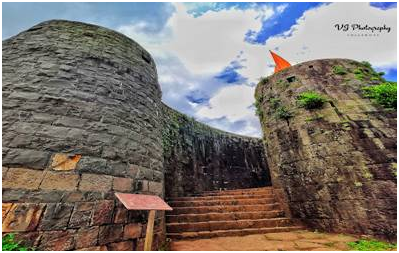
Belagavi Fort (Killa Fort)
The Belgaum Fort is a popular tourist attraction located in Belgaum. The state of Karnataka recently honoured it as the ‘State Heritage Monument’. It served as an impenetrable barricade against the violent attacks of the enemies. Mahatma Gandhi was also imprisoned here during the Freedom Movement of India. The Belgaum Fort has an adjoining lake, called the Fort Lake on which is a Floating Cafeteria. It is well maintained, and there are pedal boats as well as motorboats available for tourists.
The present-day Belgaum Fort is a result of several architectural contributions made by the changing dynasties that ruled over Belgaum. It is designed to repel the violent attacks of the invading enemy armies. The Belgaum Fort has an oval shape and is surrounded by a deep, wide moat that was excavated in soft, red stone. The original entry gate with a bridge is no longer operational. The gate that is presently being used is often quoted as an example for beautiful Indian architecture. The gate’s exterior is adorned with large motifs of birds and animals.
The changing dynasties are reflected in the variety of religious shrines in its limits. The fort displays Jain, Hindu and Muslim architectural styles and is home to Jain temples, Hindu temples and Mosques. The entrance of the fort has two shrines dedicated to Lord Ganapathi and Goddess Durga that exist in perfect harmony with two ancient mosques, Jamia Masjid and Safa Masjid demonstrating how the Belgaum Fort is a manifestation of the legacy of religious tolerance.



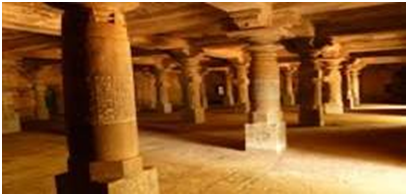

Kamal Basadi
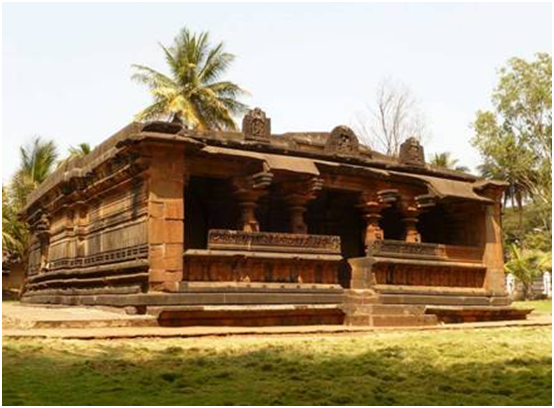
There are two Jain temples inside the Belgaum Fort - Kamal Basadi and ChikkiBasadi. Both the Jain temples reflect the Chalukyan style of architecture. Of the two, Kamal Basadi or the Lotus Jain Temple is more famous and has the Neminatha idol in black stone mounted on a stone-carved pedestal. The Archaeology Department had renovated this temple in the year of 1996. Kamal Basadi has an impressive Mukhamantapa or main hall, with a lotus carving extending from the ceiling. The temple is named aptly as the temple tower depicts a lotus or “Kamal” with 72 petals. All the pillars are intricately carved with decorations and are polished neatly. Some of the pillars are made of black basaltic stones which are believed to have magnetic properties. The other idols that can be seen in Kamal Basadi are that of BhagwanSumatinath, BhagwanParshvanath, BhagwanAdinath and the Navagraha.
The other Jain temple, ChikkiBasadi, is in ruins. It was regarded as a remarkable piece of Jain architecture during its time. The facade of the temple exhibits beautifully adorned rows of dancing figurines, trimmed flowers and musicians.
• Town Centre:
Swami Vivekananda Memorial: This is located in the house where Swami Vivekananda had stayed for 4 days in 1892 during his visit to Belagavi. In 2007, the Ramakrishna Mission took over Ramakrishna Vivekananda Sevashrama, Belagavi, which was functioning from a portion of this house. Subsequently, the entire house was acquired by the Mission and after major restoration work, it was converted into a memorial and inaugurated in 2019.

Swami Vivekananda Memorial, Belagavi.
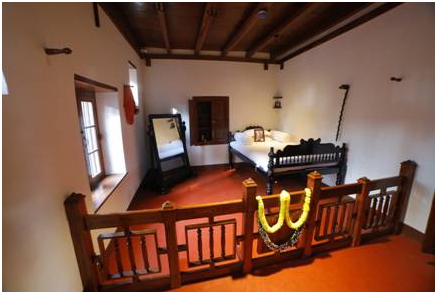
The room where Swami Vivekananda stayed.
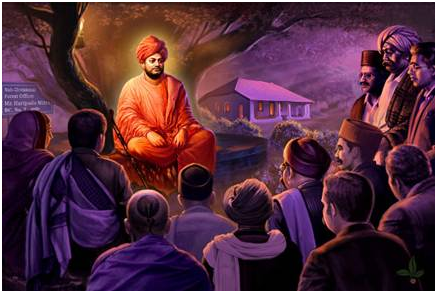
Artisits impression of Swamiji’s visit to Belgaum Pic Courtesy: Ramkrishna Mission Ashrama.
The Risaldar Galli house of Shri. Sadashiv Bhate is now a sub center of the Ramkrishna Mission Ashrama. This sub-centre has been running in a portion of the very house where Swami Vivekananda stayed for 4 days (as a guest of Shri. Sadashiv Bhate from Oct 15-18, 1892) during his 13-day visit to Belagavi. The room where Swami Vivekananda had stayed has been maintained as a shrine and also contains a cot, stick and a standing mirror said to have been used by him. The other house where Swamiji stayed for the remaining 9 days at Belagavi as a guest of Sri HaripadaMitra is now maintained as a monument within the main Ashrama at Belagavi located within the Fort.

Swami Vivekananda Value Education & Cultural Centre is also being built just next to the sub centre in Risaldar Galli.
People say Friends are forever, so I want to tell you all a story about my friends, our plan (Shailesh Kumar, Sandeep Chauhan and KunalMasta) was limited to fly from Delhi to Leh,Ladakh. We decided to leave the rest to serendipity and the local conditions. We all knew that we are going to visit the unexplored Pangong Lake. We had no clue beyond that. Locals are the unsung heroes who turn your good trip into a great one. Our case was no different. The credit for an unforgettable trip goes to –SpiceJet Ltd.
From a sweltering 45 degrees to -1 degrees, Leh was a welcome change. The change in temperature had already triggered our “happiness” hormones. Before getting into our cab, we longingly gazed at the beautiful Himalayas, in the same way as long parted lovers look at each other when they meet after ages.
The calling this time was different. There was a different tune to it. We sensed a deeper meaning, probably more than just the travel. Too often, traveling becomes just an itinerary on paper to squeeze as much in as possible. Rushing from place to place to get the boxes ticked, to snap the picture-perfect sunset and to hit the next scenic spot. Sometimes it feels like we are acquiring experiences rather than experiencing them. We had a super crammed itinerary but this time we were determined to travel slow and relish the experiences and not just gather them. As they say, the best dishes are cooked on slow and low flames. We wanted to do something different, go offbeat and live the unique experiences, for they are not found on the beaten track. And guess what, we discovered happiness in the remotest part of the world.
Happiness doesn’t require words. It can only be felt by the heart and the eyes. We were relishing our share of happiness. The mountains were mountains, smiling at me and waving at me through gestures that only we could understand🙂
Story Shared By:
Shailesh Kumar (Executive – Billing)
Sandeep Chauhan (Sr.Executive – Billing)
KunalMasta (Assistant Manager – ATF & Insurance)

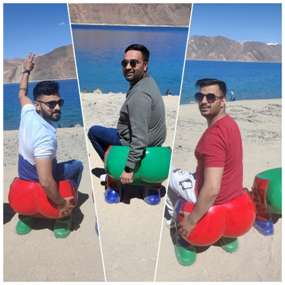
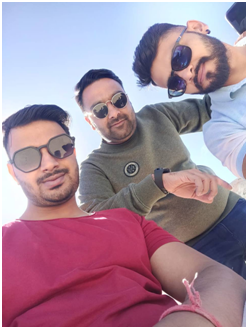

जब टूटने लगे हौंसले🌠
तो इक बात याद रखना यारों
बिना मेहनत के हासिल 🔩
तख्तों ताज नही होते !!
ढूंढ लेते है अंधेरे में भी मंजिल अपनी
क्योंकि जुगनू कभी रोशनी के मोहताज नहीं होते !
By: Sumit Sharma (CSE) - ATQ

पुरानी तस्वीर और हज़ारों जज्बात..
कुछ उन दिनों की है हमारी मुलाक़ात.!
वो चुप को उनको देखना.. और उनका मुदते ही चुप जाना..
ये सारे फलसफे... अधूरे अल्फाज... और हजारो जज्बात...!!
By: Shahnawaz Hussain (Sr. Executive – Security) - CCU



































































































































































































































































































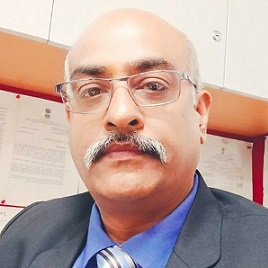
Customer satisfaction is essential for a successful business; customers must feel that you value them. The key to customer satisfaction is providing exceptional customer service, and that often begins with teamwork.
In any workplace, teamwork is critical because it brings people from diverse walks and degrees of expertise together. Unhappy consumers and poor experiences will result from a staff plagued by discontent and negativity, lowering the overall performance of the company and decreasing customer retention.
This award is result of great teamwork and hard work of the entire Varanasi team and I would like to appreciate all my team members who gave everything to make this possible.
- Rajesh Kumar Singh (APM – VNS)

It's a proud moment to be a part of this Spicy team. We are thankful and happy to receive this award. Our team is really happy and in full JOSH to serve the customers and try that every single passenger who travel with us leaves happy and with a smile.😊
- Rajan Parbhakar (APM-JLR)

As Surat is known for its diamonds worldwide, I am also blessed with many diamonds in my team.
With an experience of 15 years, I got an opportunity to work with different managers in my career and I try to adopt all good qualities from them.
Now being a leader of such a wonderful team, I try to create the best work atmosphere and motivate them and share my experience which I learned from my seniors.
With all the hard work and dedication by team members, it takes immense pleasure to announce that, Surat station again stood 1st in the month of May for the “Champions of Customer Delight Airport”, also station was awarded 1st in the month of January, February, April and now May too in “Champions Customer Delight Airport”.
We try to make each and every passenger's journey memorable by giving best customer services and also celebrate maximum world International days at the airport with passengers. And now due to that, we are best known of our good customer services, which help us to build a very good professional relations with many passengers and they always motivate us to do things better each day.
As it says, learning never ends, hence we also try to keep on learning and discover innovative ideas from which we try to make our passenger journey more joyful and memorable.
- Sachin Pillai (APM-STV)
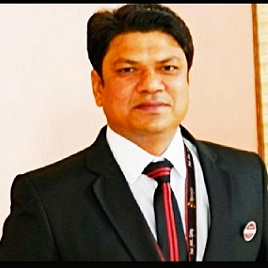
It is amazing moment that Kushinagar team become customer delight winner for May 2022. We were the winner in March 2022 and it still continues in May 2022 as it shows the consistency in the team work our team put each and every day. We continue to provide a pleasant service to our customers and it is our customers’ love and appreciation towards us. Our team is committed towards their goal and we hope we will do our best for the coming months as well.
- Kapil Kumar Khare (APM - KBK)

Ms. Sathya Bose (Sr.CSE – Madurai)


